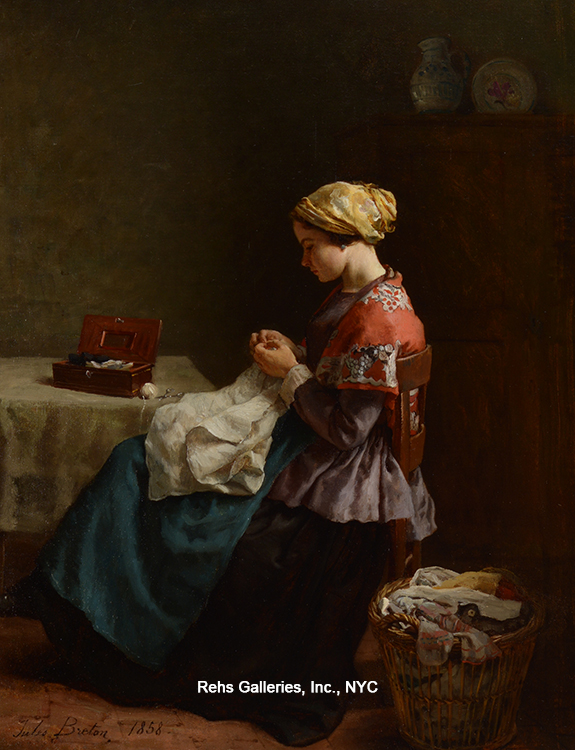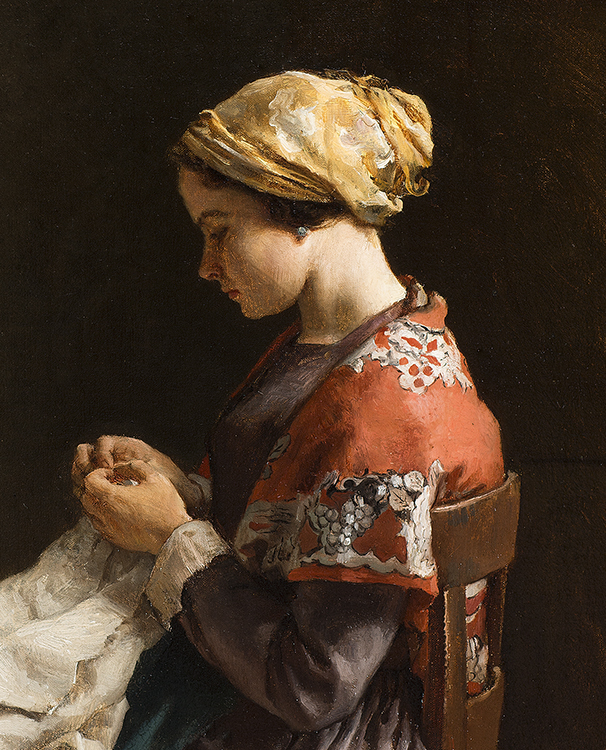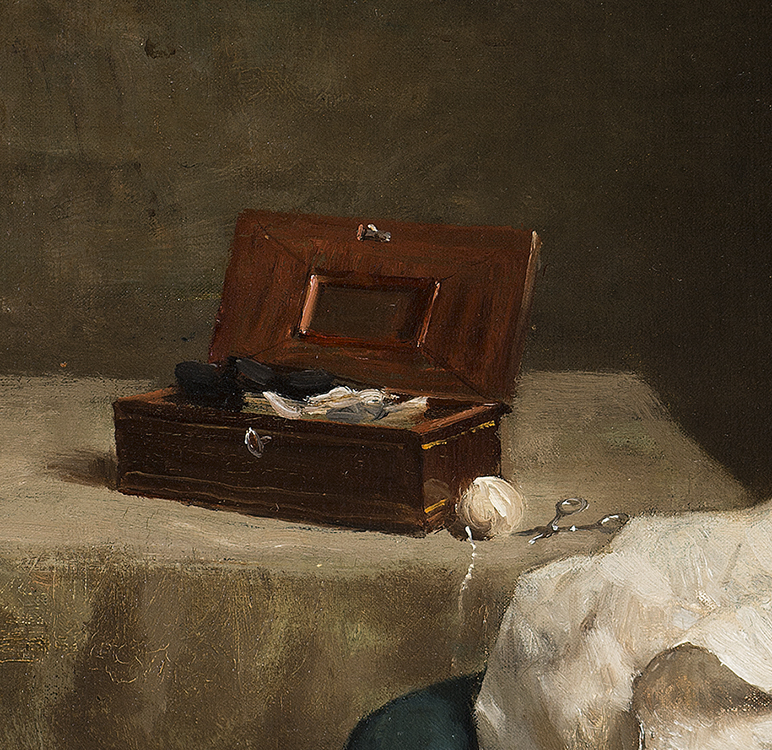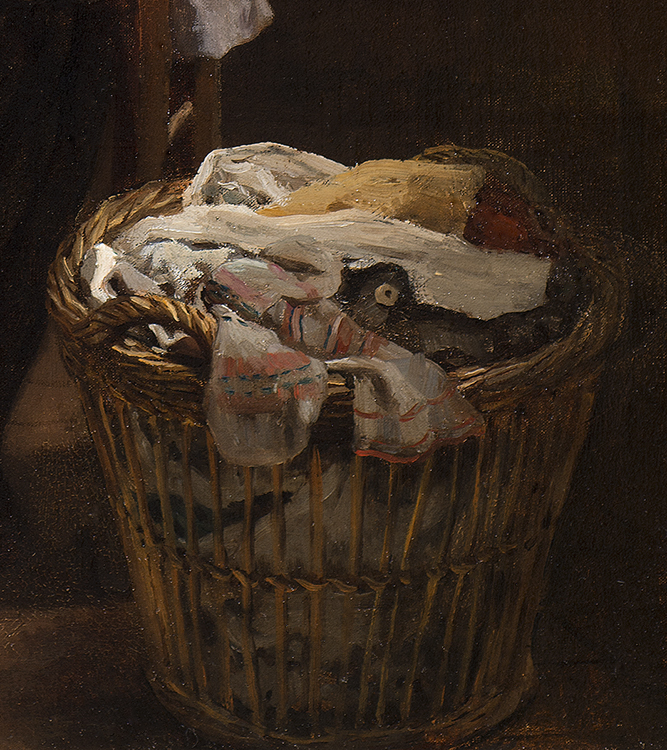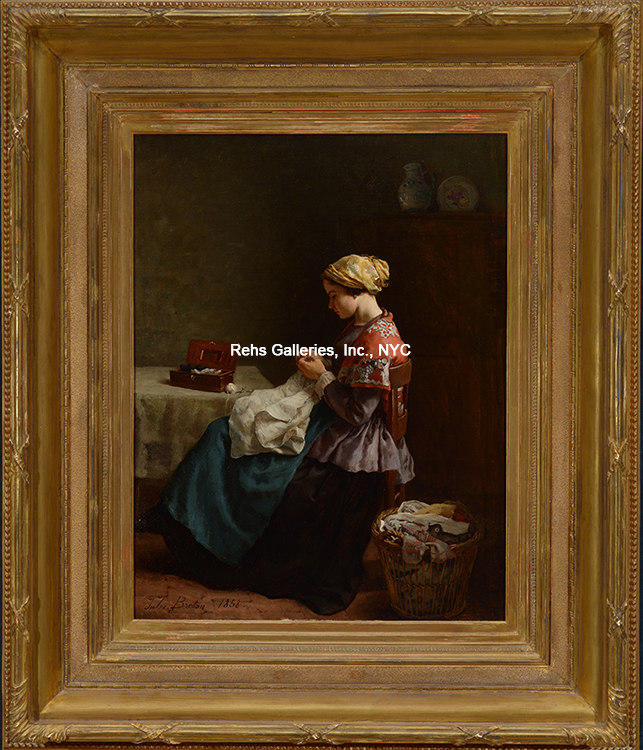Jules Breton
(1827 - 1906)
La petite couturière
Oil on canvas
22 x 16 7/8 inches
Framed dimensions:
33 x 28 inches
Signed and dated 1858
BIOGRAPHY - Jules Breton (1827 - 1906)
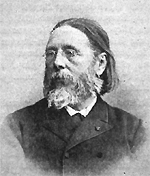
As one of the primary painters of peasant themes in the nineteenth century, and an artist strongly influenced by his own native traditions from northern France, Jules Breton’s reputation rivaled that of Eugène Delacroix or Jean-Dominique Ingres at the time of his death in 1906. Since then, after a long period of relative obscurity, Breton has returned to considerable favor; he is now regarded as a primary painter of daily life with an inherent and substantial understanding of the old masters form the Italian renaissance especially Raphael. The latter artists helped Breton fashion a highly idealist version of peasant beauty. By examining Breton’s background, it will be possible to understand how he evolved as an artist.
Jules Breton (Jules-Adolphe-Aimé-Louis Breton) was born May 1, 1827 to a well-known family from Courrières, a small village in northern France. His father was a landowner, though also worked as assistant judge and mayor, and managed the estate of the Duke of Duras. His mother died when Jules when just four years old, leaving him and his two brothers to be cared for by a nurse - Henriette, whom Breton called Mémère - their grandmother, and their uncle, Boniface Breton. At ten, Breton was sent to the Catholic seminary of St. Bertin near St. Omer. He was the black sheep among the students, often misbehaving in such ways that would warrant his father’s castigation. It was a difficult time for Breton, and upon learning that he had been slapped by the assistant director of the seminary, his father and uncle moved him to a school in Douai. There he gained his first experience with drawing and classical literature; he also took a liking to poetry after reading Racine and La Fontaine. In the summer of 1843 he met Félix de Vigne, a Belgian artist and professor in the Academy at Ghent, who initially came to view a Breton’s uncle’s collection of books pertaining to clothing from diverse periods. Invited into the Breton household, de Vigne had a chance to view some works by the young artist. Impressed by what he saw, he invited Breton to study with him on a trial period for three months - which began October 15, 1843 - at the Royal Academy in Ghent. His studies in Belgium lasted for three years, after which he worked for a short time, about five or six weeks, under Gustave Wapper, a Romantic painter in Antwerp. With both men, Jules received a strong apprenticeship in the academic tradition which was reinforced by an awareness of the old masters.
During his studies in Ghent, he had made his first trip to Paris, officially relocating there in 1847 to finish his training. He took up residence at 5, Rue du Dragon, an area where many of the Realists had settled. He began studying under Michel-Martin Drolling at the École des Beaux-Arts. It was an exciting, often intimidating experience for Breton. His provincial accent did not command respect, he was unfamiliar with the names and celebrations of the day, and he often found himself “dazed, without knowing which way to turn - wandering aimlessly on, losing myself a dozen times, and finding myself again in the same street, when I had thought myself miles away.” (Breton, The Life of an Artist: An Autobiography, New York: D. Appleton & Co.: 1897, pg. 162) He also wrote that “…I had not yet found a real friend. Habituated to the quietude of retired life, I felt myself, in the whirl of Paris, dazed and out of my element. My work long suffered from this confusion.” (pg. 167) Breton felt lost and alone, disillusioned by Paris and his lack of supportive training. But above all, he missed the countryside.
A short time later he found a friend in Charles-Joseph-Ernest Delalleau, an architect whom he had also known at St. Bertin and at college in Douai. Delalleau was instrumental in developing Breton’s political ideas and convinced him that Louis Phillipe, the current king of France under the July Monarchy, was “more cruel than Tiberius or Nero.” (pg. 177) The bloody events of the 1848 uprising against Louis-Phillipe and the July Monarchy had begun. As a witness to these events, they strongly influenced his work as well as other artists of his generation. Breton wrote that:
The causes that led to this revolution and the consequences that resulted from it exerted a powerful influence, as I have said, on my mind, and on that of every other artist, as well as on the general movement of art and literature…There was a deeper interest in the life of the street and of the fields. The tastes and the feelings of the poor were taken into account, and art conferred honors upon them…
In May of 1848 he was summoned back to Courrières, his native village, after his father fell ill. He would die shortly thereafter, and for the first time the family found themselves in debt. Through the generosity of many, however, they managed to overcome these financial difficulties. Of these two periods of war and loss, Breton wrote that “Thus it was that which grew up in my artist’s heart - a stronger affection for the nature, the obscure acts of heroism, and the beauty of the lives of the peasantry...” pg. (200)
Despite his beginning inclinations towards nature and the peasants, which would later come to fruition, Breton was first seized by a desire to create a more poignantly distressing sort of imagery. He debuted at the 1849 Salon with Misère et Désespoir (Want and Despair), a socially conscious work that clearly spoke to his experiences and understanding of the 1848-1849 conflict. In 1851 he exhibited Faim (Hunger), also a subject which highlighted the social woes of the period. Thus Breton began his artistic career with a violent sort of Realism that did not shy away from depicting the depressed state of the lower classes in Paris. Later in his career Breton would choose to comment on social and economic issues through less overt references.
By 1852 he had begun painting landscapes in the Parisian suburbs and altered his style so that it would be more suitable to Salon entries and potential patrons. His health grew more and more fragile and he returned to Courrières to regain his strength. This move back to his birthplace would not only help him through his sickness, but would provide a new sense of inspiration for his work as he was immersed in nature and the rustic life of its inhabitants. One of his most important works came out of this period, Les Glaneuses (The Gleaners), painted in 1854, which depicted peasants “gleaning” after the harvest. The principal figure in this work was his fiancée Élodie de Vigne, the daughter of his former art teacher Félix de Vigne - they were engaged April 29th, 1858. This work was exhibited at the 1855 Salon and earned him a third-class medal. This was the first time that his work was truly noticed. Breton depicted his peasants and harvesters with a sense of dignity and grace that betrayed the difficulty of the work at hand.
The subject matter of Les Glaneuses (The Gleaners) had important social and economic implications that may have earned it more respect and praise. More so than simply depicting the life of the peasantry in rural France, the act of gleaning became a symbol of France and its respected and idealized rural tradition that many were concerned was being lost in the move to industrialization. Additionally, as noted in Gabriel P. Weisberg’s The Realist Tradition: French Painting and Drawing 1830-1900 (The Cleveland Museum of Art, 1980, pg. 82), the rights of the gleaners were in question in 1854. A practice dating back several centuries, some believed that gleaning encouraged stealing while others felt that to deny women, the poor, and the handicapped the opportunity to glean was an infringement of rights. Thus, a lofty debate over the position of the gleaner was taking place at this time. While his two previous works mentioned were overt references to the social ills of the nation, Les Glaneuses focused more on a symbolic re-appreciation of traditional French values. As Breton’s work continued to depict peasant life and traditions, the working of the land and the glorification of those who worked it, the encroaching industrialization threatened to overtake these traditions. The peasants held steadfast in their maintenance of their time honored tradition and thus came to be seen as the base of stability in a world of constant change.
Breton found continued success and praise with his depictions of the peasantry. However, his poor health and continued anxiety caused by the Parisian art scene made him return to Courrières on several occasions. He exhibited Bénédictions des Blés (The Blessing of the Wheat) at the Salon of 1857 which earned him a second-class medal and was also purchased by Napoleon III on behalf of the state. He returned to Paris in 1859 and shared a studio at 53 rue Notre Dame des Champs with Delalleau. Perhaps his most important work of the 1850s, Le Rappel des Glaneuses (The Recall of the Gleaners) was awarded a first class medal at the 1859 Salon and was also sent to international exhibitions in Vienna and Luxembourg. This work was inspired by his sojourn in Marlotte on the edge of the Forest of Fontainebleau. In 1861 he was named Chevalier de la Légion d’Honneur (promoted to Officer in 1867).
While many immediately recall Breton’s peasant figures when they think of the artist, this was not His only interest, nor did his interests remain unchanged throughout his artistic career. He wrote that:
The too prolonged sight of the same objects in the end dulls the emotions. The mind constantly revolving in the same circle of observation loses its elasticity. The peasant no longer inspired me as formerly, and my imagination exhausted itself in chimerical dreams. (pg. 252)
Feeling without inspiration, he was invited by Count Duchâtel, one of Louis Phillipe’s former ministers, in 1862 to the Médoc region in southern France to paint a vintage at Château Lagrange (Les Vendages à Château-Lagrange - The Vintage at Chateau Lagrange was later exhibited at the 1864 Salon, a painting now in the Joslyn Museum in Omaha, Nebraska). He had the opportunity to travel through southern France and found Arles a most remarkable city. Of this experience Breton wrote “What remained in my mind of all the keen emotions awakened in it by the scenery of the South? Nothing which I could profit by, as far as my art was concerned, but enough to make me admire anew, and more enthusiastically than before, the simple sylvan beauty that surrounded me.” (262) From 1865 on, he also visited Brittany on several occasions, each time focusing his pictorial interest on the people working the land and local traditions such as the frequent religious pilgrimages. Works inspired by his time in Brittany – he often returned to Douarnenez during this period - form a large and important portion of Breton’s oeuvre. In 1867 he exhibited ten paintings at the Exposition Universelle and was given a first-place medal. Although he suggests that he was losing interest in depictions of peasant life, his work had come to be recognized as an idealized version of it, which appealed to the Second Empire public and government officials who wanted to reference the tranquil nature of these works which shifted attention away from the real issues that Paris faced. Increasingly, many of his paintings have overt and covert references to work from the Italian Renaissance, especially imagery by Raphael.
Breton’s work in the 1870s should be viewed against the backdrop of the Franco-Prussian war. In Jules Breton and the French Rural Tradition (New York: The Arts Publisher, Inc: 1982, pg. 16), Hollister Sturges highlights the changes in Breton’s work in response to these influences:
The rising importance of naturalism in French painting and the nationalist sentiment following the Franco-Prussian War were the most important external forces influencing the development of Breton’s work in the 1870s. While he continued to interpret rustic life with the blend of poetic sentiment, elevated style, and realistic observation that earned him so much acclaim during the Second Empire, two new, even opposing, tendencies can be seen in his work of this decade. He made his classicized peasants more monumental than those in even his most ambitious earlier works, and he painted them in a more naturalistic, vigorous, less controlled fashion.
While his style may have changed, his pictures still commanded respect and in 1872 he was given the medal of Honor at the Salon. Breton continued exhibiting at the Salons and was promoted from Officer to Commander of the Légion d’Honneur in 1885, and in 1886 he was elected as a member of the Insitut de France. In 1889-1900 he was also a jury member of the Salon. Towards the end of his career his works carried a more symbolic tone to them, often focusing on a single figure within the composition, such as Le Chant de l’Alouette (The Song of the Lark, a painting now in the Art Institute of Chicago) of 1884. This shift to attempt life-size figures may also have been influenced by his 1870 trip to Italy where he viewed the Sistine chapel and Giotto’s frescoes. After almost fifty years of consistent work, Breton’s images and execution remained fairly true to his original conception. His paintings also became avidly collected in the United States where his imagery reinforced a similar interest in rural life.
Jules Breton died on July 5, 1906 in Paris. Breton best summed up his work outside of any modern contextual analyses that may place him within the Realist - bordering occasionally on romanticism and classicism - tradition:
I have always had a passion for the Beautiful. I have always believed that the aim of art was to realize the expression of the Beautiful. I believe in the Beautiful -I feel it, I see it! If the man in me is often a pessimist, the artist, on the contrary, is pre-eminently an optimist. (pg. 289)
And in an almost prophetic sense, Breton speaks to current art connoisseurs:
The public often allow themselves to be deceived by appearances, and do not easily distinguish the false coin from the true. The crowd, led astray at first…we see them going into ecstasies before masterpieces which, at the bottom of their hearts, they still think ugly. True art will always address itself only to a limited public. (pg. 292)
Breton was perhaps foreseeing how his work would fall out of favor for a short period of time, but also speaks to current admirers after new exhibitions, and a recent new book by Annette Bourrut-Lacouture (Jules Breton: Painter of Peasant Life, Yale University Press: 2003) have ushered in a re-appreciation of his work.
Readers should note that Jules Breton was also an accomplished writer and more information on his life and theories can be gained from his two autobiographies, La Vie d’un Artiste: Une Autobiographie (1890) and Un Peintre Paysan (1896). Each of these works offers a rich source of information on Breton’s life and interests. The quotes contained within this biography have come from La Vie d’un Artiste.

